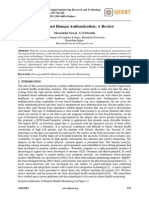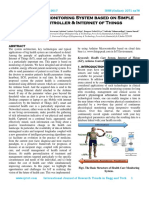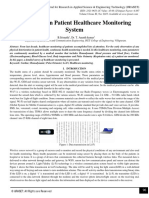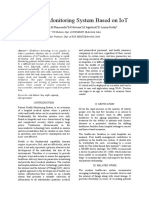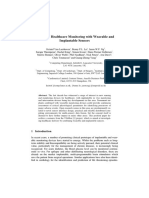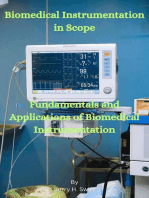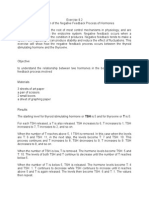3-novspiss2019 (2)
3-novspiss2019 (2)
Uploaded by
Rajasekar A.MCopyright:
Available Formats
3-novspiss2019 (2)
3-novspiss2019 (2)
Uploaded by
Rajasekar A.MCopyright
Available Formats
Share this document
Did you find this document useful?
Is this content inappropriate?
Copyright:
Available Formats
3-novspiss2019 (2)
3-novspiss2019 (2)
Uploaded by
Rajasekar A.MCopyright:
Available Formats
See discussions, stats, and author profiles for this publication at: https://www.researchgate.
net/publication/372236977
Wearable Health Monitoring System: Latest Trends and Challenges
Conference Paper · July 2023
CITATIONS READS
0 746
2 authors, including:
Hitesh Yadav
Sant Longowal Institute of Engineering and Technology
5 PUBLICATIONS 17 CITATIONS
SEE PROFILE
All content following this page was uploaded by Hitesh Yadav on 10 July 2023.
The user has requested enhancement of the downloaded file.
International Journal of Management, Technology And Engineering ISSN NO : 2249-7455
Wearable Health Monitoring System: Latest Trends and Challenges
Hitesh Yadav and Surita Maini
Department of Electrical and Instrumentation Engineering
Sant Longowal Institute of Engineering and Technology, Longowal, Sangrur, Punjab India.
{Corresponding author’s email: suritamaini@gmail.com}
Abstract- Wearable health monitoring (WHM) system blood pressure, sweat rate, heart rate, electrocardiogram,
provides a better healthcare to the people worldwide. An respiration rate etc. After the acquisition of signal its
efficient WHM system accurately capture the various preprocessing is required, where the elimination of
abnormal conditions prior it leads to death or any other
undesired signal as well as A/D conversion can be done.
fatality. Moreover, it helps to figure out the effect of
treatment or therapy on the basic of physiological Further the feature extraction part plays an important
parameters. With the enhancement in data digitization in role, after feature extraction process the desired signal
last few decades, the medical field has experienced vast either stored in a storage device that may be a hard disk
technological advancements which make the diagnostic and of a computer or transmitted to the remote location
health monitoring system more compact, power efficient
through a wireless network in the case of real time
and light weighted, those are preferably required in
wearable devices. The paper focuses on the key parameters diagnosis. A WHM system have some basic
of a typical WHM system, viz. fundamental components in characteristics such as weight and size should be
hardware design, type of sensor(s), on-chip data processor, compatible with the patient, minimum power
storage or transmission of data and various wireless consumption, highly efficient, accurate and quick
communication protocols. Besides, the paper targets to
responsive system [6& 7] etc.
cover the various parameters to be considered while
designing the ergonomic WHM system. Meanwhile, the
selection of physiological parameters to be acquired for
major disorders, the challenges in the design of reliable Data Data Real time
WHM system, recent advancements in wearable devices acquisition processing monitoring
and relevant areas to conduct further research are also unit unit unit
discussed. In future, the artificial intelligence (AI) may also
incorporate the WHM systems to decide the emergency
medication in case of doctor is not responding by
generating the local message to the patient. Fig.1.Typical block diagram of wearable health monitoring system
Keywords: Self-mixing effect; vibration measurement; 2. DATA ACQUISITION
genetic algorithm; optical feedback interferometry;
diagnostic tool. Data acquisition is the primarily goal of any WHM
1. INTRODUCTION system, various sensors are available for this data
acquisition process. Human body has different
With the increase of world population, the health electrical/bio signals that correlate with the health status
monitoring system is also necessary which monitors of the body. These signals can be acquired by various
subject’s health status if the subject is not present in the wearable devices and the information extracted from
hospital or near a medical professional. The cost of these signals plays a vital role to detect the abnormal
healthcare increases day by day so a cost effective, condition of any particular subject. While monitoring the
reliable and comfortable WHM [1& 2] can play activity of subject if any abnormality detected then
important role to predict and prevent the effects of the immediate diagnostic support is required by the medical
fatal diseases. A WHM can provide Real time professional/doctor.
monitoring and information about the affected person to
the hospital or a medical professional, which can take 2.1. Various Important Body Signals and Their
immediate preventive measures for the patient [3]. A Acquisition Techniques: Human body has various
WHM is very useful in the case of elderly peoples, physiological signals that can be measured by different
persons with chronic diseases [4& 5] etc. The main sensors. The range of these signals are different from
components of a WHM system are sensors that acquires their optimal values in case of any abnormality, so by
different body parameters such as body temperature, acquiring these physiological signals one can detect the
Volume IX, Issue XI, NOVEMBER/2019 Page No: 18
International Journal of Management, Technology And Engineering ISSN NO : 2249-7455
health condition of human body. Some useful body by BP monitoring and preventive actions can be taken
signals are explained below: before brain damage [18& 19].
2.1.1. Electrocardiogram (ECG): In 2.1.5. Respiration rate: It is a fundamental body
electrocardiography the electrodes are placed on skin or parameter that plays important role in patient’s
chest. With the help of these electrodes the heart observation. In critical illness such as hypoxia [20] it is
electrical activity can be recorded / visualized. A typical the most important indicator of patient’s health
ECG waveform consists few peaks and valleys named P, condition. Cardiac arrest [21] can also be predicted by
Q, R, S, T and U. the R peak in QRS complex is mostly respiration rate. Pulmonary diseases in children can also
used to measure the heart cycle [8].These ECG waves be monitored by separation rate monitoring [21]. In the
are useful to understand the cardiac rhythm and to case of sleep apnea syndrome, asthma and other
predict myocardial infractions[9]. Herat attack detection respiratory diseases the respiration rate monitoring is
[8] and coronary artery diseases can also be treated from important.
the information of this QRS complex. Ag/AgCl
electrodes are commonly used for ECG waveform 2.1.6. Blood Oxygen Saturation (Spo2):
detection.it is a type of wet electrode so during longer Photoplethysmography (PPG) and pulse oximetry
period acquisition the gel dries that increases the principles makes easy to estimate the blood oxygen
impedance between the human body and the electrode saturation. Normal (95-100%) range of oxygen present
that’s why the signal quality can be distorted.to avoid in the blood can be lowered (below 95%) when the
such issues now a days several dry electrodes available patient health is abnormal. An insufficient oxygen
in the market that may also use outside the medical supply to the body causes hypoxia. Anemic patients have
environment [10-12]. also lower oxygen saturation level in the blood [22]. As
the PPG [23] is popular to detect the oxygen saturation
2.1.2. Heart Rate (HR): Heart rate is one of the most level but several noninvasive techniques has been also
common parameter that indicates either the person is fit introduced that can be applied to wearable devices. An
or ill. It is the speed of the heartbeat measured by the independent wearable device for this purpose has also
number of beats of the heart per minute. The crucial been introduced [24].
information [13] can be extracted from ECG R-R peak
or photoplethysmography (PPG) signal. It is also useful 2.1.7. Blood Glucose: Blood glucose level is a
to know how the heart react during physical exercise or parameter that indicates the patient is diabetic or not. The
any mental exercise and if there is any correlation constant decreasing or increasing level of blood glucose
between these two state of body. It is also a parameter levels can cause several organ damage in human body
with the help of which a medical professional can predict such as lever, kidney etc. The monitoring of blood
abnormality or fatal condition of the patient. Human glucose level plays a vital role to prevent such fatal organ
body react differently when doing various mental or damage condition for the patient. A constant higher
physical tasks the heart rate is also different in such glucose level causes heart attack also. Various invasive
conditions stress and fatigue measurements also related methods of measuring blood glucose levels are available
with heart rate [14 &15]. in the market and now a days the noninvasive techniques
are also developed for continuous blood glucose
2.1.3. Electroencephalogram (EEG): Data of monitoring. Medtronic continuous glucose monitoring
different parts of human brain can be acquired with the (MGM) is an example of invasive device that monitors
help of EEG. It also measures spontaneous brain continuous blood glucose level, it sends the data
activities [16]. Different electrodes such as Ag/Agcl, wirelessly to a wearable insulin pump that releases
jelly electrodes and dry electrodes are available in the insulin into the body [26]. Dexcom G4 platinum is also
market for the EEG data acquisition purpose [17]. a device that measure your blood glucose level and
information will be given to a mobile device [27].
2.1.4. Blood pressure (systolic and diastolic): it is
referred as the force exerted by the circulating blood on 2.1.8. Sweat rate or skin conductivity: Sweat rate is
the walls of blood vessels. Blood pressure can also normally not used for detecting any disease in clinical
indirectly correlate with the functioning (during applications but it can be used to analyze human
contraction and relaxation) of heart. Hypertension is one behavior. When human body sweats it releases a
of the major threat for the world that can also be detected moisture that changes the electrical conductivity of the
skin. A skin galvanic response (GSR) can measure the
Volume IX, Issue XI, NOVEMBER/2019 Page No: 19
International Journal of Management, Technology And Engineering ISSN NO : 2249-7455
quantity of sweat. In [28& 29] skin sweat rate and heart Blood oxygen Oxygen content in the human blood
rate variability parameters are used to detect mental saturation Pulse oximeter is used to measure.
states. Human sweat contains sodium, calcium, Blood glucose Glucose content in the human blood
Glucometers are used to measure.
ammonium etc. so the rate of release of such compounds Sweat rate Electrical conductivity of the skin
can also correlated with the physiological condition of changed with the change of sweat
the person/patient. In [30] physical stress measured by rate
sweat rate of the military persons. Galvanic skin response are used to
measure.
2.1.9. Body temperature: Body temperature is a Body temperature Thermometer/thermistors are used to
parameter that can be checked by most of the medical measure.
professionals primarily when the patient feels any Body movements Accelerometers are used to measure.
abnormality. Human body can lose functioning due to
high temperature. Blood circulation, heart rate and
3. DATA PROCESSING
metabolic rate are the parameters that affects the skin
temperature [31]. Except these external environmental Data processing is the next step after the acquisition
factors such as air flow, humidity etc. are also the factors of data by the sensors.it is the conversion of raw data to
that affect the body temperature [32]. In [33] a wearable machine readable format. Data processing involves
temperature detection system has been proposed. further steps:
2.1.10. Body movements: Motion sensors are commonly 3.1. Preprocessing: The raw data acquired by the sensors
used for rehabilitation, to analyze how a particular task contains noise, various artifacts and other sensor error
is completed by patient. Except these body postures, related issues. A/D conversion, unusual data removal
muscle activities can also be monitored with the help of [36& 37] and noise removal are some common benefits
motion sensors. Athlete performance improvement, of preprocessing of raw data in healthcare system. ECG
fatigue detection due to wrong body movement are also preprocessing [38] has been done that involves filtering
the applications of such monitoring. Arm movement [34] and other statistical tools. Power spectral density [39]
timing is analyzed during basketball through. and fast Fourier transforms are used to remove frequency
Accelerometers are used for the measurement of noise. A low pass filtering [40] is used to remove the
acceleration in 3D space. For the more accurate artifacts from the acquired signal. Data normalization
monitoring gyroscope and magnetometers can also and synchronization has been done with the help of
embedded in wearable sensors [35]. With the help of preprocessing when the data is taken from the sensors.
these parameters the various states of human body can Sometimes the data acquired may be unreliable and
be monitored.
massive so the preprocessing step required.
Table I. Different types of signals and their descriptions
Type of signal Description 3.2. Feature Extraction/Selection: The main objective of
EEG Measures the spontaneous brain feature extraction is to find the main characteristics of
activities during the performance of the acquired data set [41]. The acquired data have
any task. different in complexity and magnitude so the feature
Electrodes placed on the scalp or extraction process can differentiate the data and helps to
inside the scalp.
ECG Electrical activity of the heart, QRS
find the common pattern of the data that is helpful to
waveform can be measured. make decisions [42]. Several classifiers are also used for
Chest electrodes are used to this purpose [43]. Features extraction can be done in time
measure. domain or in frequency domain. In sensor data
Blood pressure Force on the walls of blood vessels acquisition the time domain feature extraction is
exerted by blood circulated in it.
common that includes basic waveform characteristic
Systolic and diastolic pressures are
the thresholds for the measuring analysis, other statistical parameters such as mean,
device. variance etc. [44& 45]. Frequency domain analysis is
Heart rate Expressed as the Frequency of also beneficial and used frequently now a days. Power
cardiac cycle spectral density, filtering, spectral energy comparison
Pulse oximeters are used to measure.
[46] can be done with the help of frequency domain
Respiration rate Is also known as breathing rate
Piezoelectric sensors are used to analysis. Data classifiers such as support vector
measure. mechanism (SVM) [47], neural networks [48] are used
Volume IX, Issue XI, NOVEMBER/2019 Page No: 20
International Journal of Management, Technology And Engineering ISSN NO : 2249-7455
for the classification of data. Except these various that’s why they are far away from the reach of a common
classification/selection methods are available. man. Except the cost some other issues such as ethically
approved, data safety, device efficiency, reliability etc.
3.3. Storage or Transmission of Data: The monitoring of are also plays important role towards the common
the patient is the final step in WHM system, it can be acceptance of such devices.
done inside the hospital or outside the hospital
environment. A daily activity monitoring system [49] 5. CONCLUSION
has been proposed. The vital information can be
provided to the patient itself or transmitted to the doctor As the acceptance of wearable systems increases the
or medical professional that can take immediate action at production of such devices also increased from the last
the critical condition of the patient. This vital signal can few years so it’s a good news that more investments in
also be transmitted to an ambulance or any relative of the R&D of wearable’s. Wearable health systems are able to
patient. These vital signal can be recorded and saved for monitor various important body parameters with the help
the further analysis of medical professional. A micro SD of advance sensors, so the life span of humans can
card or a hard disk is used for the storage of data. Using increase with the help of WHM systems. Nanomaterial
the internet and mobile networks any one can be based signal amplifications, sensor size minimization
monitored inside hospital or inside/outside home. WHM and biocompatibility are the future aspects of WHM
system provides a normal life to the patient while being systems [53& 54].
monitored for medical status. [50] Proposed a system
REFERENCES
that provides a real time monitoring for elderly peoples.
The vital signs transmitted by the various [1] Seoane, F.; Mohino-Herranz, I.; Ferreira, J.; Alvarez, L.; Buendia,
communication methods. Various wireless R.; Ayllon, D.; Llerena, C.; Gil-Pita, R.Wearable biomedical
measurement systems for assessment of mental stress of
communication protocols viz Zigbee, Wi-Fi, Bluetooth combatants in real time.Sensors 2014, 14, 7120–7141.
etc. are available for data communication purpose. The [2] Yilmaz, T.; Foster, R.; Hao, Y. Detecting vital signs with wearable
table below shows different wireless communication wireless sensors. Sensors 2010, 10, 10837–10862.
protocols, their limitations and other parameters. [3] Marco Di Rienzo, G.P.; Brambilla, G.; Ferratini, M.; Castiglioni,
P. MagIC System: A New Textile-Based Wearable Device for
Table II. Various wireless communication protocols Biological Signal Monitoring. Applicability in Daily Life and
Different Range Max Data Power Clinical Setting. In Proceedings of the 2005 IEEE, Engineering in
protocols rate consumption Medicine and Biology 27th Annual Conference 2005, Shangai,
Zigbee 10-75 m 250 kbps 30 Mw China, 1–4 September 2005; pp. 7167–7169
[4] P. Bonato, “Advances in wearable technology and applications in
Wi-fi 150-200 54 mbps 1W
physical medicine and rehabilitation,” J. NeuroEng. Rehabil., vol.
m
2, p. 2, Feb.2005
Bluetooth 10-100 m 3 mbps 2.5-100Mw [5] P. Bonato, “Wearable sensors/systems and their impact on
Mics 2m 500kbps 25 micro W biomedical engineering,” IEEE Eng. Med. Biol. Mag., vol. 22, no.
3, pp. 18–20, May/Jun. 2003.
4. LATEST DEVELOPMENTS IN WEARABLE [6] D. Raskovic, T. Martin, and E. Jovanov, “Medical monitoring
DEVICES AND CHALLENGES applications for wearable computing,” Comput. J., vol. 47, pp.
495–504, Apr.2004
[7] U. Anliker, J. Beutel, M. Dyer, R. Enzler, P. Lukowicz, L. Thiele,
Wearable health devices are now a days becoming
and G. Tr¨oster, “A systematic approach to the design of
popular. These devices can help to detect, prevent and distributed wearable systems,” IEEE Trans. Comput., vol. 53, no.
diagnose any abnormality regarding human health. 8, pp. 1017–1033, Aug.2004
Smart watches are used frequently that monitors sleep [8] Saritha, C.; Sukanya, V.; Murthy, Y.N. ECG Signal Analysis
UsingWavelet Transforms. Bulg. J. Phys. 2008, 35,68–77
quality, heart rate, activity tracking, calorie counting [9] Xu, P.J.; Zhang, H.; Tao, X.M. Textile-structured electrodes for
during workout etc. AMON 2002 [51] was the first such electrocardiogram. Text. Prog. 2008, 40,183–213.
device that can monitor such body parameters. Google [10] Seoane, F.; Mohino-Herranz, I.; Ferreira, J.; Alvarez, L.;
eye lens is one of the latest innovation in the field of Buendia, R.; Ayllon, D.; Llerena, C.; Gil-Pita, R.Wearable
biomedical measurement systems for assessment of mental stress
wearable technology. Except this Vital Jacket, of combatants in real time. Sensors 2014, 14, 7120–7141.
Moov(activity tracker), BioPatch, sensoTRACK ear [11] Xu, P.J.; Zhang, H.; Tao, X.M. Textile-structured electrodes for
sensor, EEG T-Shirt devices are some of the latest electrocardiogram. Text. Prog. 2008, 40, 183–213.
developments in the field of wearable technology. Total [12] Luo, N.; Ding, J.; Zhao, N.; Leung, B.H.K.; Poon, C.C.Y. Mobile
Health: Design of Flexible and StretchableElectrophysiological
revenue in wearable devices sector is just doubled from Sensors for Wearable Healthcare Systems. In Proceedings of the
2014 to 2017(from $2.8 billion to $4.5 billion) [52]. 2014 11th InternationalConference on Wearable and Implantable
Most of the available wearable devices are expensive
Volume IX, Issue XI, NOVEMBER/2019 Page No: 21
International Journal of Management, Technology And Engineering ISSN NO : 2249-7455
Body Sensor Networks, Zurich, Switzerland, 16–19 June 2014; [31] Popovic, Z.; Momenroodaki, P.; Scheeler, R. Toward wearable
pp. 87–91. wireless thermometers for internal body temperature
[13] Chan, M.; Esteve, D.; Fourniols, J.Y.; Escriba, C.; Campo, E. measurements. IEEE Commun. Mag. 2014, 52, 118–125.
Smart wearable systems: Current status and future challenges. [32] Buller, M.J.; Tharion,W.J.; Hoyt, R.W.; Jenkins, O.C. Estimation
Artif. Intell. Med. 2012, 56, 137–156. of human internal temperature from wearable physiological
[14] Ahrens, T. The most important vital signs are not being sensors. In Proceedings of the Twenty-Second Innovative
measured. Aust. Crit Care 2008, 21, 3–5. Applications of Artificial Intelligence Conference (IAAI-10),
[15] Xiao-Fei, T.; Yuan-Ting, Z.; Poon, C.C.Y.; Bonato, P. Wearable Atlanta, GA, USA, 11–15 July 2010.
Medical Systems for p-Health. IEEE Rev. Biomed. Eng. 2008, 1, [33] Webb, R.C.; Bonifas, A.P.; Behnaz, A.; Zhang, Y.; Yu, K.J.;
62–74. Cheng, H.; Shi, M.; Bian, Z.; Liu, Z.; Kim, Y.S.; et al. Ultrathin
[16] J.R. Millan, F. Renkens, J. Mourino, W. Gerstner, Noninvasive conformal devices for precise and continuous thermal
brain-actuated control of a mobile robot by human EE", IEEE characterization of human skin. Nat. Mater. 2013, 12, 938–944.
Trans. Biomed. Eng. 51 (6) (2004) 1026–1033 [34] Buckley, C.; Reilly, M.A.O.; Whelan, D.; Farrell, A.V.; Clark,
[17] H. Nakasaki, T. Mitomi, T. Noto, K. Ogoshi, H. Hanaue, Y. L.; Longo, V.; Gilchrist, M.D.; Caulfield, B. Binary
Tanaka, H. Makuuchi,H. Clausen, S.I. Hakomori, Mosaicism in Classification of Running Fatigue using a Single Inertial
the expression of tumor-associated carbohydrate antigens in Measurement Unit. In Proceedings of the 14th Annual Body
human colonic and gastric cancers, Cancer Res. 49 (13) (1989) Sensor Networks Conference, Eindhoven, The Netherlands, 9–12
3662–3669 May 2017; pp. 197–201.
[18] Elliott, M.C.A. Critical care: The eight vital signs of patient [35] Mohammed, S.; Tashev, I. Unsupervised Deep Representation
monitoring. Br. J. Nurs. 2012, 21, 621–625. Learning to Remove Motion Artifacts in Free-mode Body Sensor
[19] Turner, J.R.; Viera, A.J.; Shimbo, D. Ambulatory blood pressure Networks. In Proceedings of the 14th Annual Body Sensor
monitoring in clinical practice: A review. Am. J. Med. 2015, 128, Networks Conference, Eindhoven, The Netherlands, 9–12 May
14–20. 2017; pp. 182–188.
[20] Elliott, M.C.A. Critical care: The eight vital signs of patient [36] Sow, D.; Turaga, D.; Schmidt, M. Mining of Sensor Data in
monitoring. Br. J. Nurs. 2012, 21, 621–625. Healthcare: A Survey. In Managing and Mining Sensor Data;
[21] Xiao-Fei, T.; Yuan-Ting, Z.; Poon, C.C.Y.; Bonato, P. Wearable Aggarwal, C.C., Ed.; Springer: Berlin, Germany, 2013; pp. 459–
Medical Systems for p-Health. IEEE Rev. Biomed. Eng. 2008, 1, 504.
62–74. [37] Lara, O.D.; Labrador, M.A. A survey on ambient-assisted living
[22] Tamura, T.; Maeda, Y.; Sekine, M.; Yoshida, M. Wearable tools for older adults. IEEE Commun. Surv. Tutor. 2013, 15,
Photoplethysmographic Sensors—Past and Present. Electronics 1192–1209.
2014, 3, 282–302. [38] Apiletti, D.; Baralis, E.; Bruno, G.; Cerquitelli, T. Real-time
[23] Dias, D.; Ferreira, N.; Cunha, J.P.S. Vital Logger: An adaptable analysis of physiological data to support medical applications.
wearable physiology and body-area ambiance data logger for Trans. Info. Tech. Biomed. 2009, 13, 313–321.
mobile applications. In Proceedings of the 2017 IEEE 14th [39] Hu, F.; Jiang, M.; Celentano, L.; Xiao, Y. Robust medical ad hoc
International Conference on Wearable and Implantable Body sensor networks (MASN) with wavelet-based ECG data mining.
Sensor Networks (BSN), Eindhoven, The Netherlands, 9–12 May Ad Hoc Netw. 2008, 6, 986–1012
2017; pp. 71–74. [40] Frantzidis, C.A.; Bratsas, C.; Klados, M.A.; Konstantinidis, E.;
[24] Sola, J.; Castoldi, S.; Chetelat, O. SpO2 Sensor Embedded in a Lithari, C.D.; Vivas, A.B.; Papadelis, C.L.; Kaldoudi, E.; Pappas,
Finger Ring: Desing and implementation. In Proceedings of the C.; Bamidis, P.D. On the classification of emotional biosignals
2006 International Conference of the IEEE Engineering in evoked while viewing affective pictures: An integrated data-
Medicine and Biology Society, New York, NY, USA, 30 mining-based approach for healthcare applications. Trans. Inf.
August–3 September 2006; pp. 4495–4498 Tech. Biomed. 2010, 14, 309–318.
[25] Krehel, M.; Wolf, M.; Boesel, L.F.; Rossi, R.M.; Bona, G.L.; [41] Guyon, I.; Gunn, S.; Nikravesh, M.; Zadeh, L.A. Feature
Scherer, L.J. Development of a luminous textile for reflective Extraction: Foundations and Applications (Studies in Fuzziness
pulse oximetry measurements. Biomed. Opt. Express 2014, 5, and Soft Computing); Springer: Secaucus, NJ, USA, 2006
2537–2547. [42] Bellos, C.C.; Papadopoulos, A.; Rosso, R.; Fotiadis, D.I.
[26] Medtronic MiniMed, I. Continuous Glucose Monitoring. Extraction and Analysis of Features Acquired By Wearable
Available online: https://www.medtronicdiabetes.com (accessed Sensors Network. In Proceedings of 10th IEEE International
on 7 July 2017) Conference on Information Technology and Applications in
[27] Dexcom, I. Dexcom G4 Platinum. Available online: Biomedicine, Corfu, Greece, 3–5 November 2010; pp. 1–4.
http://www.dexcom.com/pt-PT (accessed on 7 July 2017). [43] Mao, Y.; Chen,W.; Chen, Y.; Lu, C.; Kollef, M.; Bailey, T. An
[28] Leehoon, K.; Sungjun, K.; Sangwon, S.; Kwangsuk, P. Highly Integrated Data Mining Approach to Real-Time Clinical
wearable galvanic skin response sensor using flexible and Monitoring and Deterioration Warning. In Proceedings of the
conductive polymer foam. In Proceedings of the 2014 36th 18th ACM SIGKDD International Conference on Knowledge
Annual International Conference of the IEEE Engineering in Discovery and Data Mining, Beijing, China, 16–18 August 2012;
Medicine and Biology Society (EMBC), Chicago, IL, USA, 26– pp. 1140–1148.
30 August 2014; pp. 6631–6634. [44] Apiletti, D.; Baralis, E.; Bruno, G.; Cerquitelli, T. Real-time
[29] Nikolic-Popovic, J.; Goubran, R. Measuring heart rate, breathing analysis of physiological data to support medical applications.
rate and skin conductance during exercise. In Proceedings of the Trans. Info. Tech. Biomed. 2009, 13, 313–321.
2011 IEEE InternationalWorkshop on the Medical [45] Singh, R.R.; Conjeti, S.; Banerjee, R. An Approach for Real-
Measurements and Applications Proceedings (MeMeA), Bari, Time Stress-Trend Detection Using Physiological Signals in
Italy, 30–31 May 2011; pp. 507–511. Wearable Computing Systems for Automotive Drivers. In
[30] Bandodkar, A.J.;Wang, J. Non-invasive wearable Proceedings of the 14th International IEEE Conference on
electrochemical sensors: A review. Trends Biotechnol. 2014, 32, Intelligent Transportation Systems, Washington, DC, USA, 5–7
363–371. October 2011; pp. 1477–1482.
Volume IX, Issue XI, NOVEMBER/2019 Page No: 22
International Journal of Management, Technology And Engineering ISSN NO : 2249-7455
[46] Gialelis, J.; Chondros, P.; Karadimas, D.; Dima, S.; Serpanos, D. health-monitoring systems. Sensors 2012, 12, 13907–13946.
Identifying Chronic Disease Complications Utilizing State of the [CrossRef] [PubMed]
Art Data Fusion Methodologies and Signal Processing [51] Lukowicz, P.; Anliker, U.; Ward, J.; Troster, G.; Hirt, E.; Neufelt,
Algorithms. In Wireless Mobile Communication and Healthcare; C. AMON: A wearable medical computer for high risk patients.
Nikita, K.S., Lin, J.C., Fotiadis, D.I., Arredondo Waldmeyer, In Proceedings of the Sixth International Symposium
M.T., Eds.; Springer: Berlin, Germany, 2012; Volume 83, pp. onWearable Computers, Seattle, WA, USA, 10 October 2002; pp.
256–263. 133–134.
[47] Cortes, C.; Vapnik, V. Support-vector networks. Mach. Learn. [52] IHS Technology. World Market for Telehealth—2014 Edition;
1995, 20, 273–297. IHS Markit: London, UK, 2014.
[48] Paliwal, M.; Kumar, U.A. Neural networks and statistical [53] Bandodkar, A.J.;Wang, J. Non-invasive wearable
techniques: A review of applications. Expert. Syst. Appl. 2009, electrochemical sensors: A review. Trends Biotechnol. 2014,32,
36, 2–17. 363–371. [CrossRef] [PubMed]
[49] Pantelopoulos, A.; Bourbakis, N.G. A Survey on Wearable [54] Pantelopoulos, A.; Bourbakis, N.G. A Survey on Wearable
Sensor-Based Systems for Health Monitoring and Prognosis. Sensor-Based Systems for Health Monitoring and Prognosis.
IEEE Trans. Syst. Man Cybern. Part C Appl. Rev. 2010, 40, 1– IEEE Trans. Syst. Man Cybern. Part C Appl. Rev. 2010, 40, 1–
12. [CrossRef] 12. [CrossRef]
[50] Custodio, V.; Herrera, F.J.; Lopez, G.; Moreno, J.I. A review on
architectures and communications technologies for wearable
Volume IX, Issue XI, NOVEMBER/2019 Page No: 23
View publication stats
You might also like
- Pedia Drugs and Dosages SlidesDocument25 pagesPedia Drugs and Dosages SlidesWipaporn ChaengsriNo ratings yet
- 2005 FRACP Written Examination Paediatrics & ChildDocument30 pages2005 FRACP Written Examination Paediatrics & ChildMedicEdNo ratings yet
- Nursing Care Plan For Cesarean SectionDocument5 pagesNursing Care Plan For Cesarean SectionJon Gab Paquit85% (33)
- ECG Based Human Authentication: A Review: Meenakshi Nawal, G.N PurohitDocument8 pagesECG Based Human Authentication: A Review: Meenakshi Nawal, G.N PurohitPhạm Minh KhuêNo ratings yet
- A Wireless Health Monitoring System Using Mobile Phone AccessoriesDocument10 pagesA Wireless Health Monitoring System Using Mobile Phone AccessoriesMca SaiNo ratings yet
- Photoplethysmography in Wearable Devices A ComprehDocument24 pagesPhotoplethysmography in Wearable Devices A Comprehavinandan.mallickNo ratings yet
- Ding 2020Document14 pagesDing 20200442- TARUNNo ratings yet
- Remote Healthcare Monitoring SystemDocument5 pagesRemote Healthcare Monitoring Systemnallamal1006No ratings yet
- Wireless Physiological Parameter Monitoring and Recording SystemDocument11 pagesWireless Physiological Parameter Monitoring and Recording SystemInternational Organization of Scientific Research (IOSR)No ratings yet
- Telemedicine ReportDocument26 pagesTelemedicine ReportFaiyaz FarahNo ratings yet
- IOTHealthcare MonitoringDocument7 pagesIOTHealthcare Monitoringgirish chandra YadavNo ratings yet
- 1 s2.0 S0140366406000508 Main PDFDocument13 pages1 s2.0 S0140366406000508 Main PDFBrianAQsumaNo ratings yet
- Health Monitoring System Using MicrocontrollerDocument8 pagesHealth Monitoring System Using MicrocontrollerIJRASETPublicationsNo ratings yet
- Developing IoT Based Fall Detection SystemsDocument6 pagesDeveloping IoT Based Fall Detection SystemsRadioGAGANo ratings yet
- BPJ Vol 8 No2 P 1093-1102Document10 pagesBPJ Vol 8 No2 P 1093-1102PSNA VIJAYNo ratings yet
- Health Monitoring Using Internet of Things (Iot)Document5 pagesHealth Monitoring Using Internet of Things (Iot)Tanusri GhoshNo ratings yet
- Health Care Monitoring System Based On Simple Microcontroller Internet of ThingsDocument6 pagesHealth Care Monitoring System Based On Simple Microcontroller Internet of ThingsShashank SayanwarNo ratings yet
- UNIT - IV WearableDocument40 pagesUNIT - IV WearableajithaNo ratings yet
- Ambulatory Cardiac Bio-SignalsDocument14 pagesAmbulatory Cardiac Bio-SignalsLuis SuarezNo ratings yet
- UNIT VDocument66 pagesUNIT Vckparul001No ratings yet
- A Review - Android Based Health Care Monitoring SystemDocument9 pagesA Review - Android Based Health Care Monitoring Systemdeshmukhds2492No ratings yet
- Wireless Health Care MonitoringDocument6 pagesWireless Health Care Monitoringking philipNo ratings yet
- Medical Monitor PDFDocument5 pagesMedical Monitor PDFFábio Vitor MartinsNo ratings yet
- Medical MonitorDocument5 pagesMedical MonitorDanangNo ratings yet
- Patient Monitoring Using Zigbee-MainDocument9 pagesPatient Monitoring Using Zigbee-Mainm_bhaskarkNo ratings yet
- A Real Time Cardiac Arrhythmia Classification System With Wearable Sensor NetworksDocument27 pagesA Real Time Cardiac Arrhythmia Classification System With Wearable Sensor NetworksSubash S VersatileNo ratings yet
- Developing A Medical Device Structures That Support Remote Monitoring For Cardiovascular PatientsDocument13 pagesDeveloping A Medical Device Structures That Support Remote Monitoring For Cardiovascular PatientsMai Trang DoNo ratings yet
- A Review On Patient Healthcare Monitoring SystemDocument6 pagesA Review On Patient Healthcare Monitoring SystemIJRASETPublicationsNo ratings yet
- Health Monitoring System Based On Iot: I Sai Bharadwaj, M Phaneendra, M Naveena, M Jagadeesh, D Laxma ReddyDocument5 pagesHealth Monitoring System Based On Iot: I Sai Bharadwaj, M Phaneendra, M Naveena, M Jagadeesh, D Laxma Reddysai bharadwajNo ratings yet
- IoT Based Health Monitoring System@Document17 pagesIoT Based Health Monitoring System@atikpNo ratings yet
- 2024 JanuaryDocument8 pages2024 Januaryet12091999No ratings yet
- On Development of Mysignals Based Prototype For Application in Health Vitals MonitoringDocument18 pagesOn Development of Mysignals Based Prototype For Application in Health Vitals Monitoringbiomedical bpiNo ratings yet
- Internet Based Highly Secure Data Transmission System in Health Care Monitoring SystemDocument6 pagesInternet Based Highly Secure Data Transmission System in Health Care Monitoring SystemIJRES teamNo ratings yet
- Health CNN-SMO: To Secure and Enhance The Medical Healthcare System by Using Convolution Neural NetworkDocument4 pagesHealth CNN-SMO: To Secure and Enhance The Medical Healthcare System by Using Convolution Neural NetworkInternational Journal of Innovative Science and Research TechnologyNo ratings yet
- Wannenburg Body 2015Document14 pagesWannenburg Body 2015Carlo JimenezNo ratings yet
- Wireless Health Care MonitoringDocument6 pagesWireless Health Care MonitoringHairil HanifNo ratings yet
- Smart Health Monitoring Systems - An Overview of Design and Modeling - Baig - 2013Document14 pagesSmart Health Monitoring Systems - An Overview of Design and Modeling - Baig - 2013Shâmara Stéfany GuimarãesNo ratings yet
- Journal On IOT Based Health Monitoring SystemDocument8 pagesJournal On IOT Based Health Monitoring SystemHeena AsrafNo ratings yet
- Survey Health PDFDocument12 pagesSurvey Health PDFAman MohantyNo ratings yet
- Medical Healthcare Monitoring With Wearable and Implantable SensorsDocument6 pagesMedical Healthcare Monitoring With Wearable and Implantable SensorsGeneration GenerationNo ratings yet
- Final EditDocument33 pagesFinal EditSajanNo ratings yet
- Pationt Monitoring SystemDocument3 pagesPationt Monitoring SystemRajeevan ArunNo ratings yet
- Artigo Mobile SaúdeDocument12 pagesArtigo Mobile SaúdeNathielle AlvesNo ratings yet
- IOTHealthcare MonitoringDocument7 pagesIOTHealthcare Monitoringrizwankashmiri985No ratings yet
- 2018 - Mobile Health-Monitoring System With Inference Fall Detection and Cardiovascur Prediction - Yin-Fu HuangDocument14 pages2018 - Mobile Health-Monitoring System With Inference Fall Detection and Cardiovascur Prediction - Yin-Fu HuangAnonymous l0EgezNo ratings yet
- Health Monitoring and Management System by Using Wireless Sensor Network and Internet of Things (Iot)Document7 pagesHealth Monitoring and Management System by Using Wireless Sensor Network and Internet of Things (Iot)Alejandro Uribe LopezNo ratings yet
- 9B Documentation (MAJOR)Document55 pages9B Documentation (MAJOR)dulipala alekya gupthaNo ratings yet
- Development of A Vital Signs Monitoring Device For Hospital Patients With MicrocontrollersDocument7 pagesDevelopment of A Vital Signs Monitoring Device For Hospital Patients With MicrocontrollersIJAR JOURNALNo ratings yet
- The Use of AI in Enhancing Patient Monitoring Systems (WWW - Kiu.ac - Ug)Document4 pagesThe Use of AI in Enhancing Patient Monitoring Systems (WWW - Kiu.ac - Ug)publication1No ratings yet
- Novel Approach of A Smart Medical Mirror System For Medical ApplicationsDocument6 pagesNovel Approach of A Smart Medical Mirror System For Medical Applicationschieftains380No ratings yet
- Smart Wearable Body Sensors For Patient Self-Assessment and MonitoringDocument9 pagesSmart Wearable Body Sensors For Patient Self-Assessment and MonitoringshivnairNo ratings yet
- Project B.TechDocument5 pagesProject B.TechNarender Reddy KampelliNo ratings yet
- Health Monitoring Tracking System Using GPS and GSM ModuleDocument2 pagesHealth Monitoring Tracking System Using GPS and GSM ModuleEditor IJTSRDNo ratings yet
- Bio Medical InstrumentationDocument5 pagesBio Medical InstrumentationpearllineNo ratings yet
- Research and Development of Smart Health Monitoring System: Department of E.C.E - S.V.I.T - Seminar ReportDocument33 pagesResearch and Development of Smart Health Monitoring System: Department of E.C.E - S.V.I.T - Seminar ReportVinay KumarNo ratings yet
- Wireless Photoplethysmography Sensor For ContinuouDocument9 pagesWireless Photoplethysmography Sensor For Continuouavinandan.mallickNo ratings yet
- Internet of Things IoT Based Healthcare Monitoring System Using NodeMCU and Arduino UNODocument5 pagesInternet of Things IoT Based Healthcare Monitoring System Using NodeMCU and Arduino UNOEditor IJTSRD100% (1)
- Health Monitoring Using Mobile Phones: Course:-Mobile Networking Instructor: - Dr. Helmy AhmedDocument40 pagesHealth Monitoring Using Mobile Phones: Course:-Mobile Networking Instructor: - Dr. Helmy AhmedsmritiNo ratings yet
- Integrated Non-Invasive Cardiovascular Imaging: A Guide for the PractitionerFrom EverandIntegrated Non-Invasive Cardiovascular Imaging: A Guide for the PractitionerNo ratings yet
- Systems Design for Remote HealthcareFrom EverandSystems Design for Remote HealthcareKoushik MaharatnaNo ratings yet
- Clinical Decision Support System: Fundamentals and ApplicationsFrom EverandClinical Decision Support System: Fundamentals and ApplicationsNo ratings yet
- Sponsorship For Migration To Australia: (Parent, Aged Dependent Relative, Remaining Relative, Carer)Document14 pagesSponsorship For Migration To Australia: (Parent, Aged Dependent Relative, Remaining Relative, Carer)ambush_143No ratings yet
- Cholestyramine (Drug Study)Document2 pagesCholestyramine (Drug Study)Franz.thenurse6888No ratings yet
- Kamus-ICD-10-ICD-9 ADocument5 pagesKamus-ICD-10-ICD-9 Anoerrekmed_816409184No ratings yet
- BSC 100 Midterm Questions For Oral ExamDocument20 pagesBSC 100 Midterm Questions For Oral ExamNovochino CastilloNo ratings yet
- Radiology in Pediatric Dentistry 2Document44 pagesRadiology in Pediatric Dentistry 2Aima Cuba100% (1)
- Vitamin P Group of The C Complex by Royal Lee - Vitamin News 1948Document2 pagesVitamin P Group of The C Complex by Royal Lee - Vitamin News 1948larrevityNo ratings yet
- Anemia Its Laboratory DiagnosisDocument146 pagesAnemia Its Laboratory DiagnosisCh M MushahidNo ratings yet
- 08 Brewer DietDocument5 pages08 Brewer DietUmm AbdullahNo ratings yet
- PGD PRCS 1Document15 pagesPGD PRCS 1gabgabb1123zNo ratings yet
- HRSL ScriptsDocument3 pagesHRSL ScriptsFolajimi AdebowaleNo ratings yet
- Wing Commander (DR) Suresh Tahiliani AIMA-Accredited Management TeacherDocument50 pagesWing Commander (DR) Suresh Tahiliani AIMA-Accredited Management TeacherMehak KapoorNo ratings yet
- Introduction To ErgonomicsDocument48 pagesIntroduction To ErgonomicsPaul Entrata100% (1)
- Otto Warburg's Contributions To Cancer MetabolismDocument13 pagesOtto Warburg's Contributions To Cancer Metabolismsatya_chagantiNo ratings yet
- Herbal Based Pain Balm Formulation For Pain ReliefDocument6 pagesHerbal Based Pain Balm Formulation For Pain ReliefMr.S. p.royNo ratings yet
- Gestational Trophoblastic Disease (GTD)Document72 pagesGestational Trophoblastic Disease (GTD)Mohammad BelbahaithNo ratings yet
- Wellness Program 8211 Tine Van Der Maas BlogDocument3 pagesWellness Program 8211 Tine Van Der Maas BlogproducttesterzaNo ratings yet
- ICU protocol 2015 قصر العيني by mansdocsDocument227 pagesICU protocol 2015 قصر العيني by mansdocsWalaa YousefNo ratings yet
- BSA Creat Clearance Calculation OriginalDocument2 pagesBSA Creat Clearance Calculation Originalstrider_sdNo ratings yet
- Tattoo Culture and Influence in SocietyDocument2 pagesTattoo Culture and Influence in SocietySuryansh GuptaNo ratings yet
- CertificateDocument1 pageCertificateSIDDIQUE AHMEDNo ratings yet
- Cartones-Bingo-1-30 ACTDocument5 pagesCartones-Bingo-1-30 ACTkeisymararaujoNo ratings yet
- Ignaz Semmelweis - Britannica Online EncyclopediaDocument3 pagesIgnaz Semmelweis - Britannica Online EncyclopediaGReadRNo ratings yet
- Urinary SystemDocument20 pagesUrinary SystemKelvin MallariNo ratings yet
- Lectures On Homoeopathic Philosophy James Tyler Kent.07063 1contentsDocument5 pagesLectures On Homoeopathic Philosophy James Tyler Kent.07063 1contentsNEHA N0% (1)
- Negative FeedbackDocument2 pagesNegative FeedbackCharlene ElioNo ratings yet
- Lena Popovich Oet Nurses LetterDocument3 pagesLena Popovich Oet Nurses LetterJithu P JamesNo ratings yet
- Cyanogenetic PlantsDocument34 pagesCyanogenetic PlantsAmmara AmyNo ratings yet



